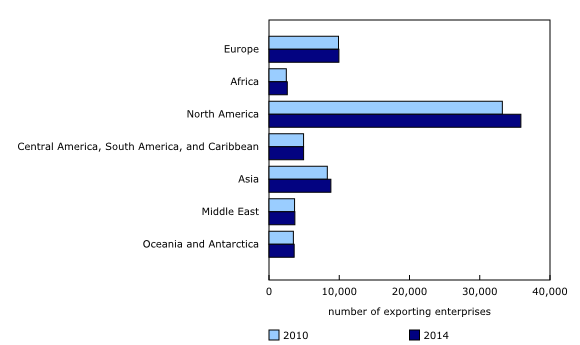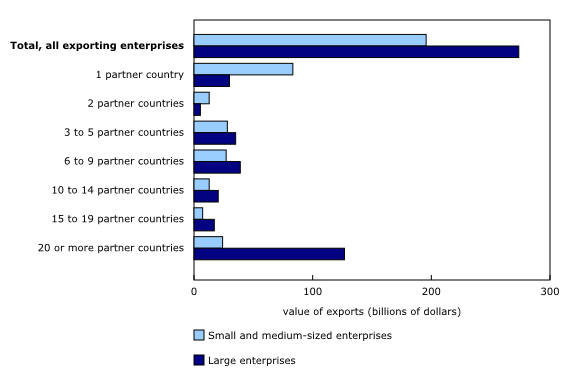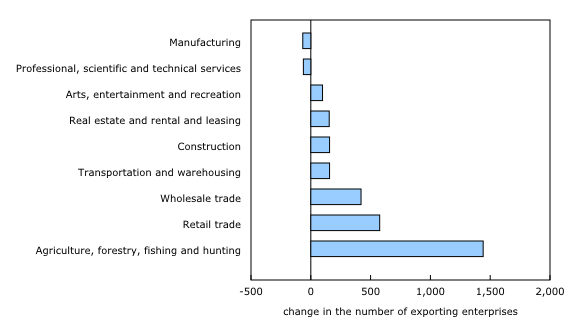Trade by Exporter Characteristics: Goods, 2010 to 2014
Archived Content
Information identified as archived is provided for reference, research or recordkeeping purposes. It is not subject to the Government of Canada Web Standards and has not been altered or updated since it was archived. Please "contact us" to request a format other than those available.
Released: 2016-10-25
In 2014, 43,530 enterprises exported goods from Canada, generating $469.3 billion in sales. Compared with 2010, the number of exporting enterprises was up 7.2%, while export sales grew 30.4%.
Small and medium-sized enterprises (SMEs) accounted for 97.3% of all exporting enterprises, and over 40% of all export sales in 2014. In contrast, large enterprises accounted for 2.7% of all exporting enterprises, but were responsible for nearly 60% of the total value of export sales.
Exports were concentrated among a small number of enterprises from 2010 to 2014. Each year, the top 10 exporting enterprises accounted for about one-quarter of all export sales, while the top 1,000 exporting enterprises represented over 85%.
Increase in the number of exporting enterprises led by small and medium-sized enterprises
There were 2,919 more exporting enterprises in Canada in 2014 than in 2010, nearly all of which were SMEs. Export sales rose $109.4 billion from 2010 to 2014. The increase was almost evenly split between SMEs and large enterprises, with export sales up 39.5% for SMEs and up 24.6% for large enterprises.
The increase in exporting enterprises over the period was concentrated among enterprises that export to North America, mainly the United States. SMEs were responsible for the bulk of the gain. The number of enterprises exporting goods to Asia, mainly China, and Africa also rose, reflecting a higher number of both SMEs and large enterprises.
Large enterprises reach more foreign markets compared with small and medium-sized enterprises
SMEs primarily exported to one partner country in 2014, while most large enterprises traded with multiple partner countries. Overall, nearly one-third of all export sales were generated by enterprises selling to 20 or more partner countries in 2014. From 2010 to 2014, the increase in export sales was led by enterprises that export to multiple partner countries.
Despite growth in the number of exporting SMEs from 2010 to 2014, the proportion of SMEs that export to more than one country remained at about 30% each year.
More exporting enterprises in the agriculture, forestry, fishing and hunting, retail trade, and wholesale trade sectors
Manufacturing and wholesale trade were the two sectors with the largest number of exporting enterprises in 2014, representing nearly 25,700 exporters. These two sectors accounted for two-thirds of all export sales.
There were almost 15,700 exporting enterprises in the manufacturing sector in 2014, generating $234.9 billion in export sales. Over one-third of this sector's export sales were from enterprises in the transportation equipment manufacturing subsector. This activity was highly concentrated, with 54 large enterprises accounting for over 90% of this subsector's export sales.
Although smaller in size, the agriculture, forestry, fishing and hunting sector accounted for 3,867 exporting enterprises in 2014, up 1,441 from 2010. The number of exporting enterprises rose notably in the retail trade and wholesale trade sectors. In contrast, the manufacturing, and professional, scientific and technical services sectors both recorded slight declines.
Note to readers
The Trade by Exporter Characteristics (TEC) – Goods program is an initiative at Statistics Canada undertaken to analyze the business characteristics of exporters in Canada. These estimates are formed by linking customs trade data records to business entities in Statistics Canada's Business Register.
Data on exports to the United States are collected by the US Census Bureau and transmitted to Statistics Canada as part of the Canada–US data exchange, while data on exports to the rest of the world are collected jointly by Statistics Canada and the Canada Border Services Agency.
The Business Register contains the complete operating and legal structure of enterprises operating in Canada, as well as their key characteristics such as employment and North American Industry Classification System code.
Survey concepts
This release of the TEC – Goods program contains information at both the enterprise and establishment levels. An enterprise is defined as the statistical unit that directs and controls the allocation of resources relating to its domestic operations, and for which consolidated financial statements are maintained. An establishment is defined as the statistical unit where the accounting data required to measure production is available. The two measures generate a different number of exporting units as well as a different industry allocation of these units.
Small and medium-sized enterprises are enterprises that employ fewer than 500 employees, including those that did not report any employment. Large enterprises have 500 or more employees.
Detailed concepts and methodology relating to this release are available on the TEC – Goods program survey page (5124).
Survey coverage
In this release, the total value of exports refers to the part of the annual domestic export value (customs basis) that can be linked to specific entities in the Business Register each year. Annual domestic export values (customs basis) can be obtained from CANSIM table 228-0060. Additional information and definitions related to domestic merchandise exports is available on the survey page for Canadian International Merchandise Trade (Customs Basis) (2201).
Each year from 2010 to 2014, the total number of identified exporting enterprises accounted for 95% to 96% of the total domestic export value. In this release, the percentage share of export sales corresponds to the share of the annual domestic export value for which there was an identified exporting enterprise. The number of exporting enterprises corresponds to the number of exporting enterprises identified in the Business Register by the TEC – Goods program.
Products
The Methodological Guide: Canadian System of Macroeconomic Accounts (13-607-X) is available from the Browse by key resource module of our website, under Publications.
The User Guide: Canadian System of Macroeconomic Accounts (13-606-G) is also available from the Browse by key resource module of our website, under Publications. This publication will be regularly updated to maintain its relevance.
Contact information
For more information, contact us (toll-free 1-800-263-1136; 514-283-8300; STATCAN.infostats-infostats.STATCAN@canada.ca).
To enquire about the concepts, methods or data quality of this release, contact Angela Yuan-Wu (613-240-2871; angela.yuanwu@canada.ca) or Shivani Sood (613-790-5210; shivani.sood@canada.ca), International Accounts and Trade Division.
- Date modified:




